Systems Engineering Case Study 2022
VerifiedAdded on 2022/09/25
|15
|2547
|23
AI Summary
Contribute Materials
Your contribution can guide someone’s learning journey. Share your
documents today.
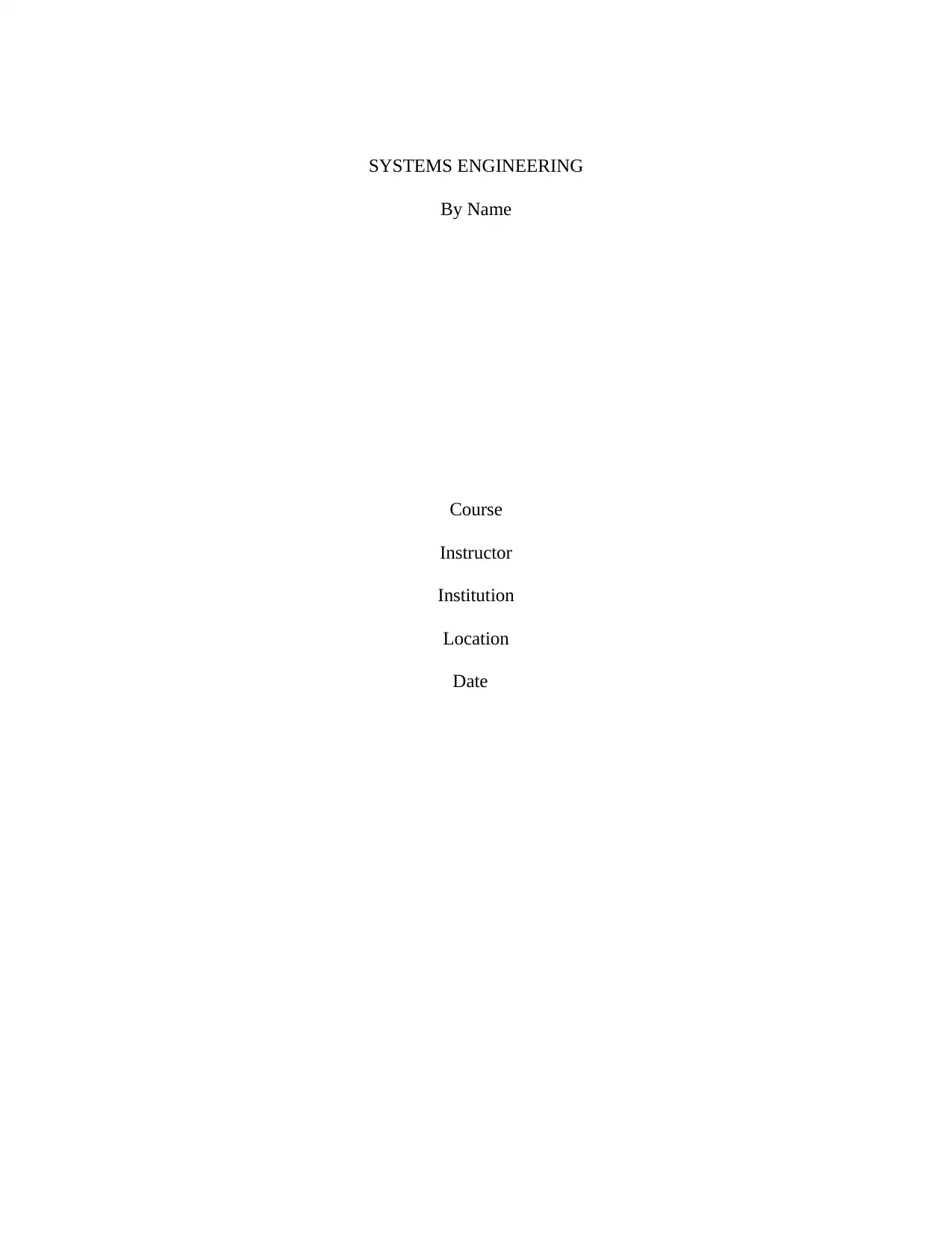
SYSTEMS ENGINEERING
By Name
Course
Instructor
Institution
Location
Date
By Name
Course
Instructor
Institution
Location
Date
Secure Best Marks with AI Grader
Need help grading? Try our AI Grader for instant feedback on your assignments.
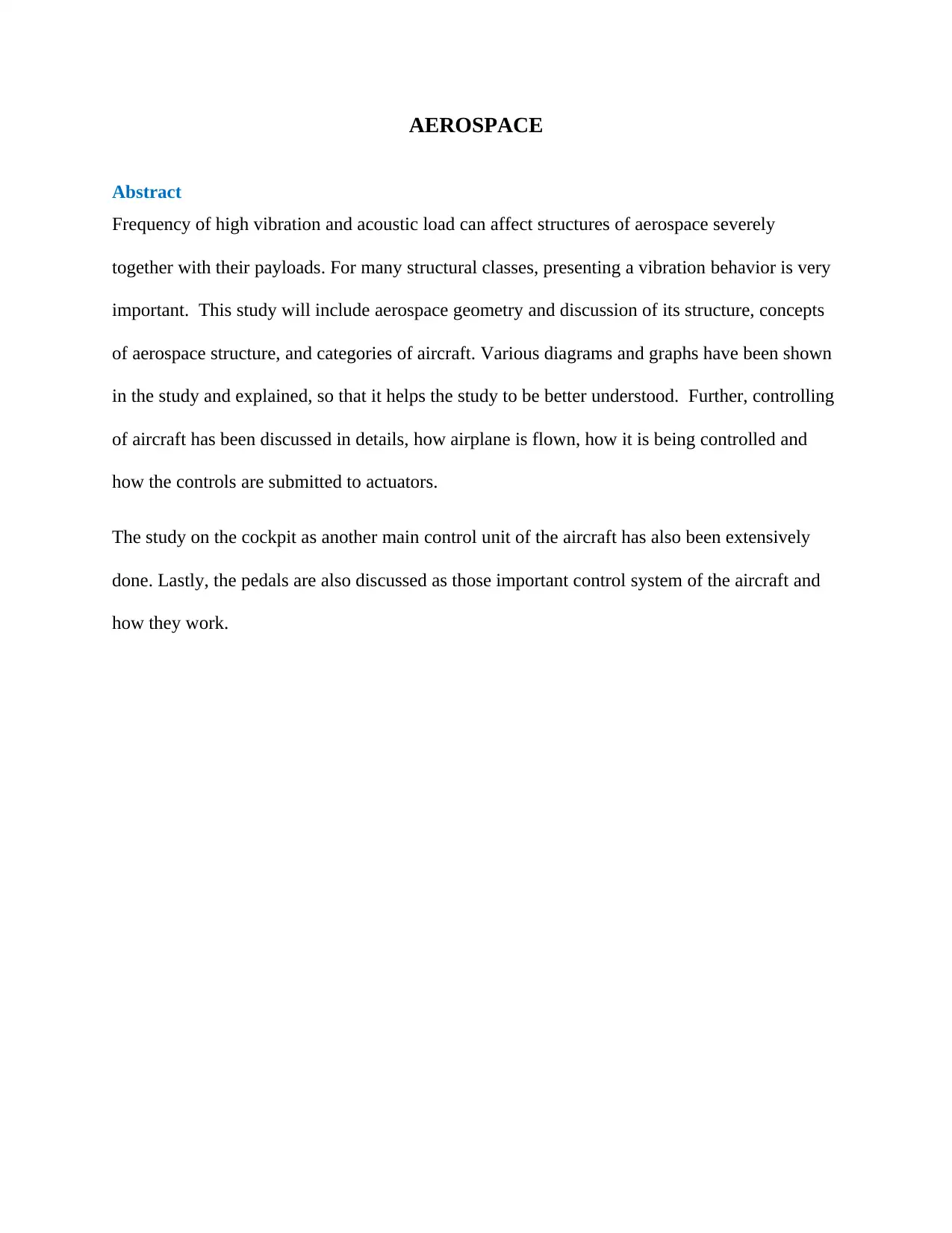
AEROSPACE
Abstract
Frequency of high vibration and acoustic load can affect structures of aerospace severely
together with their payloads. For many structural classes, presenting a vibration behavior is very
important. This study will include aerospace geometry and discussion of its structure, concepts
of aerospace structure, and categories of aircraft. Various diagrams and graphs have been shown
in the study and explained, so that it helps the study to be better understood. Further, controlling
of aircraft has been discussed in details, how airplane is flown, how it is being controlled and
how the controls are submitted to actuators.
The study on the cockpit as another main control unit of the aircraft has also been extensively
done. Lastly, the pedals are also discussed as those important control system of the aircraft and
how they work.
Abstract
Frequency of high vibration and acoustic load can affect structures of aerospace severely
together with their payloads. For many structural classes, presenting a vibration behavior is very
important. This study will include aerospace geometry and discussion of its structure, concepts
of aerospace structure, and categories of aircraft. Various diagrams and graphs have been shown
in the study and explained, so that it helps the study to be better understood. Further, controlling
of aircraft has been discussed in details, how airplane is flown, how it is being controlled and
how the controls are submitted to actuators.
The study on the cockpit as another main control unit of the aircraft has also been extensively
done. Lastly, the pedals are also discussed as those important control system of the aircraft and
how they work.
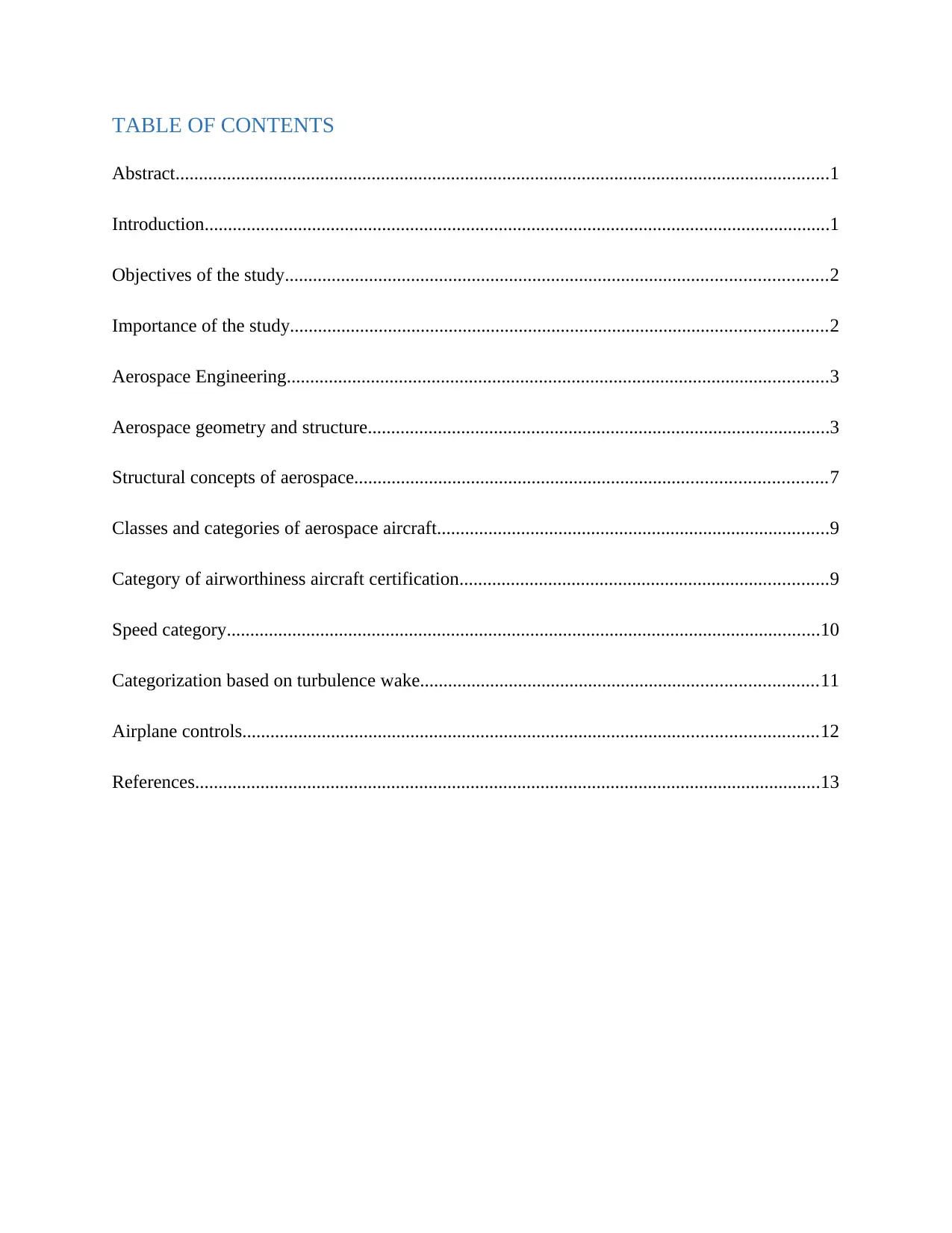
TABLE OF CONTENTS
Abstract............................................................................................................................................1
Introduction......................................................................................................................................1
Objectives of the study....................................................................................................................2
Importance of the study...................................................................................................................2
Aerospace Engineering....................................................................................................................3
Aerospace geometry and structure...................................................................................................3
Structural concepts of aerospace.....................................................................................................7
Classes and categories of aerospace aircraft....................................................................................9
Category of airworthiness aircraft certification...............................................................................9
Speed category...............................................................................................................................10
Categorization based on turbulence wake.....................................................................................11
Airplane controls...........................................................................................................................12
References......................................................................................................................................13
Abstract............................................................................................................................................1
Introduction......................................................................................................................................1
Objectives of the study....................................................................................................................2
Importance of the study...................................................................................................................2
Aerospace Engineering....................................................................................................................3
Aerospace geometry and structure...................................................................................................3
Structural concepts of aerospace.....................................................................................................7
Classes and categories of aerospace aircraft....................................................................................9
Category of airworthiness aircraft certification...............................................................................9
Speed category...............................................................................................................................10
Categorization based on turbulence wake.....................................................................................11
Airplane controls...........................................................................................................................12
References......................................................................................................................................13
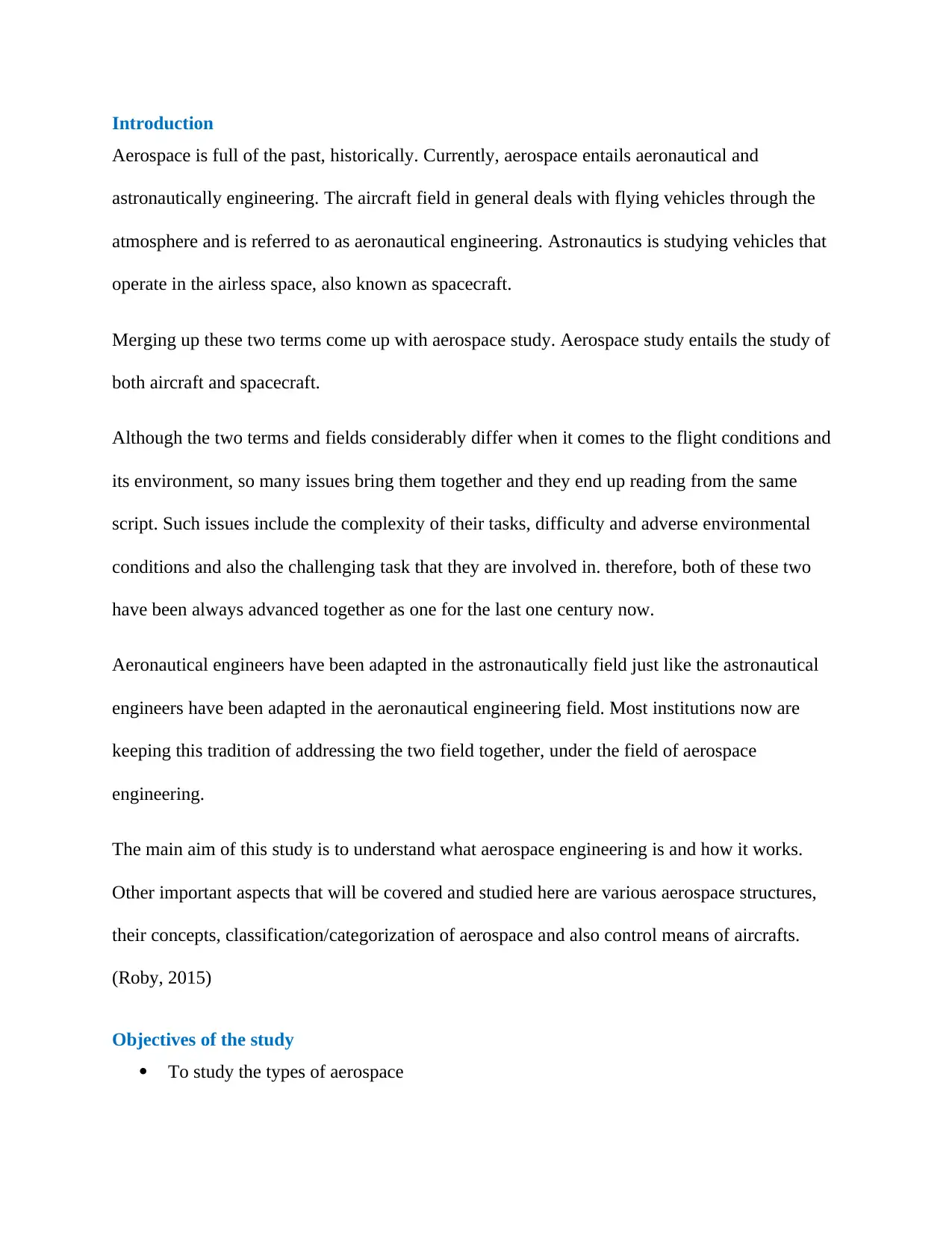
Introduction
Aerospace is full of the past, historically. Currently, aerospace entails aeronautical and
astronautically engineering. The aircraft field in general deals with flying vehicles through the
atmosphere and is referred to as aeronautical engineering. Astronautics is studying vehicles that
operate in the airless space, also known as spacecraft.
Merging up these two terms come up with aerospace study. Aerospace study entails the study of
both aircraft and spacecraft.
Although the two terms and fields considerably differ when it comes to the flight conditions and
its environment, so many issues bring them together and they end up reading from the same
script. Such issues include the complexity of their tasks, difficulty and adverse environmental
conditions and also the challenging task that they are involved in. therefore, both of these two
have been always advanced together as one for the last one century now.
Aeronautical engineers have been adapted in the astronautically field just like the astronautical
engineers have been adapted in the aeronautical engineering field. Most institutions now are
keeping this tradition of addressing the two field together, under the field of aerospace
engineering.
The main aim of this study is to understand what aerospace engineering is and how it works.
Other important aspects that will be covered and studied here are various aerospace structures,
their concepts, classification/categorization of aerospace and also control means of aircrafts.
(Roby, 2015)
Objectives of the study
To study the types of aerospace
Aerospace is full of the past, historically. Currently, aerospace entails aeronautical and
astronautically engineering. The aircraft field in general deals with flying vehicles through the
atmosphere and is referred to as aeronautical engineering. Astronautics is studying vehicles that
operate in the airless space, also known as spacecraft.
Merging up these two terms come up with aerospace study. Aerospace study entails the study of
both aircraft and spacecraft.
Although the two terms and fields considerably differ when it comes to the flight conditions and
its environment, so many issues bring them together and they end up reading from the same
script. Such issues include the complexity of their tasks, difficulty and adverse environmental
conditions and also the challenging task that they are involved in. therefore, both of these two
have been always advanced together as one for the last one century now.
Aeronautical engineers have been adapted in the astronautically field just like the astronautical
engineers have been adapted in the aeronautical engineering field. Most institutions now are
keeping this tradition of addressing the two field together, under the field of aerospace
engineering.
The main aim of this study is to understand what aerospace engineering is and how it works.
Other important aspects that will be covered and studied here are various aerospace structures,
their concepts, classification/categorization of aerospace and also control means of aircrafts.
(Roby, 2015)
Objectives of the study
To study the types of aerospace
Secure Best Marks with AI Grader
Need help grading? Try our AI Grader for instant feedback on your assignments.
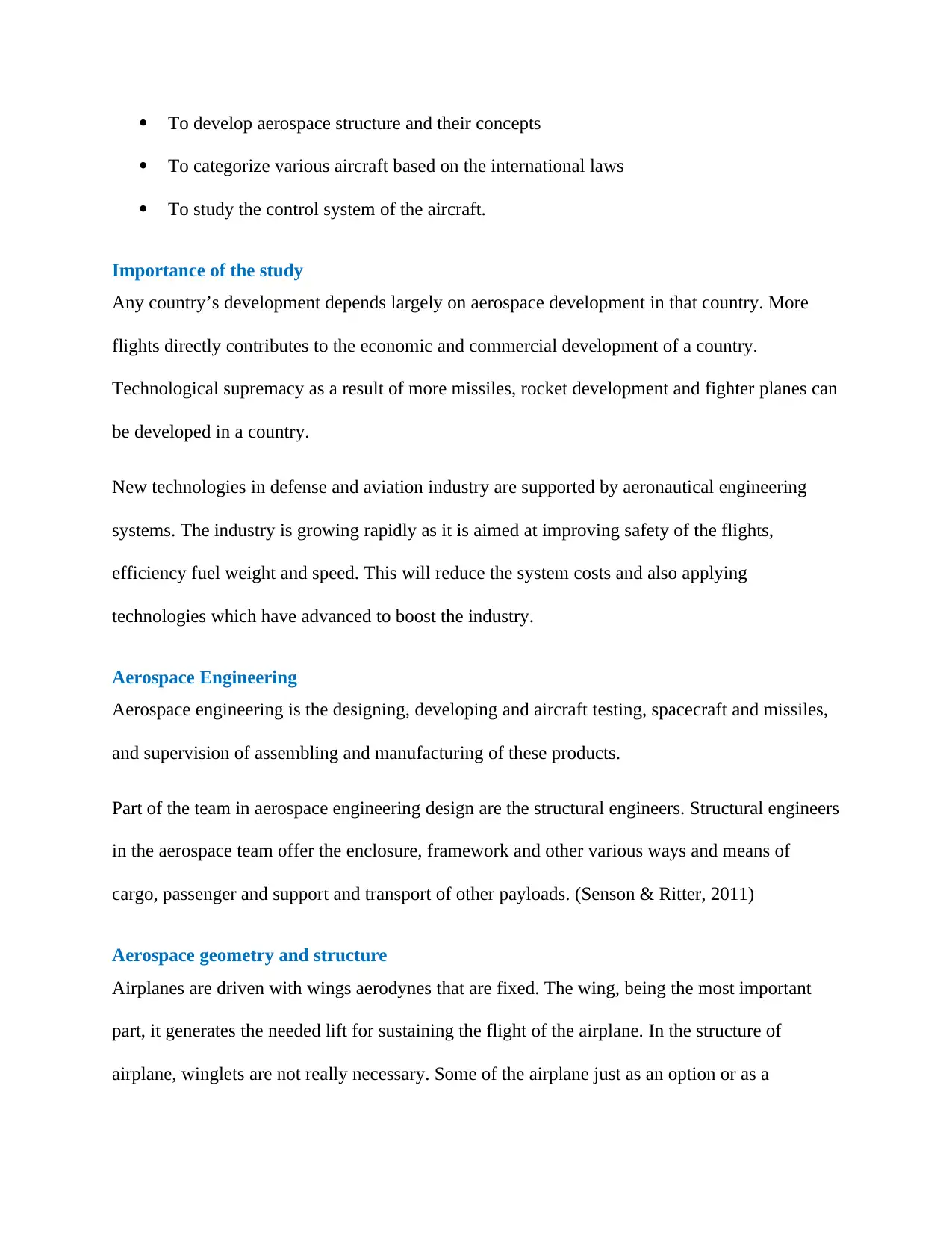
To develop aerospace structure and their concepts
To categorize various aircraft based on the international laws
To study the control system of the aircraft.
Importance of the study
Any country’s development depends largely on aerospace development in that country. More
flights directly contributes to the economic and commercial development of a country.
Technological supremacy as a result of more missiles, rocket development and fighter planes can
be developed in a country.
New technologies in defense and aviation industry are supported by aeronautical engineering
systems. The industry is growing rapidly as it is aimed at improving safety of the flights,
efficiency fuel weight and speed. This will reduce the system costs and also applying
technologies which have advanced to boost the industry.
Aerospace Engineering
Aerospace engineering is the designing, developing and aircraft testing, spacecraft and missiles,
and supervision of assembling and manufacturing of these products.
Part of the team in aerospace engineering design are the structural engineers. Structural engineers
in the aerospace team offer the enclosure, framework and other various ways and means of
cargo, passenger and support and transport of other payloads. (Senson & Ritter, 2011)
Aerospace geometry and structure
Airplanes are driven with wings aerodynes that are fixed. The wing, being the most important
part, it generates the needed lift for sustaining the flight of the airplane. In the structure of
airplane, winglets are not really necessary. Some of the airplane just as an option or as a
To categorize various aircraft based on the international laws
To study the control system of the aircraft.
Importance of the study
Any country’s development depends largely on aerospace development in that country. More
flights directly contributes to the economic and commercial development of a country.
Technological supremacy as a result of more missiles, rocket development and fighter planes can
be developed in a country.
New technologies in defense and aviation industry are supported by aeronautical engineering
systems. The industry is growing rapidly as it is aimed at improving safety of the flights,
efficiency fuel weight and speed. This will reduce the system costs and also applying
technologies which have advanced to boost the industry.
Aerospace Engineering
Aerospace engineering is the designing, developing and aircraft testing, spacecraft and missiles,
and supervision of assembling and manufacturing of these products.
Part of the team in aerospace engineering design are the structural engineers. Structural engineers
in the aerospace team offer the enclosure, framework and other various ways and means of
cargo, passenger and support and transport of other payloads. (Senson & Ritter, 2011)
Aerospace geometry and structure
Airplanes are driven with wings aerodynes that are fixed. The wing, being the most important
part, it generates the needed lift for sustaining the flight of the airplane. In the structure of
airplane, winglets are not really necessary. Some of the airplane just as an option or as a
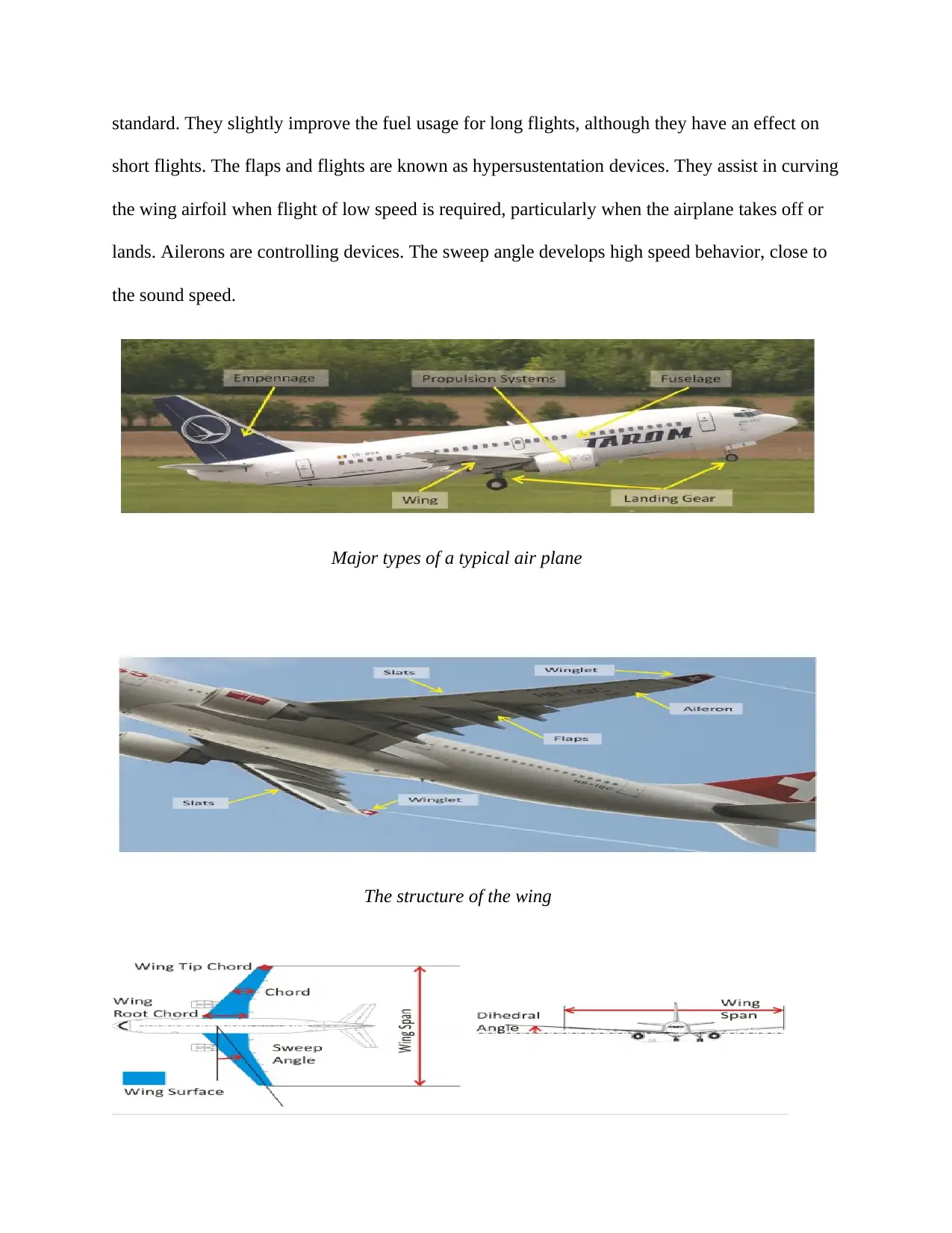
standard. They slightly improve the fuel usage for long flights, although they have an effect on
short flights. The flaps and flights are known as hypersustentation devices. They assist in curving
the wing airfoil when flight of low speed is required, particularly when the airplane takes off or
lands. Ailerons are controlling devices. The sweep angle develops high speed behavior, close to
the sound speed.
Major types of a typical air plane
The structure of the wing
short flights. The flaps and flights are known as hypersustentation devices. They assist in curving
the wing airfoil when flight of low speed is required, particularly when the airplane takes off or
lands. Ailerons are controlling devices. The sweep angle develops high speed behavior, close to
the sound speed.
Major types of a typical air plane
The structure of the wing
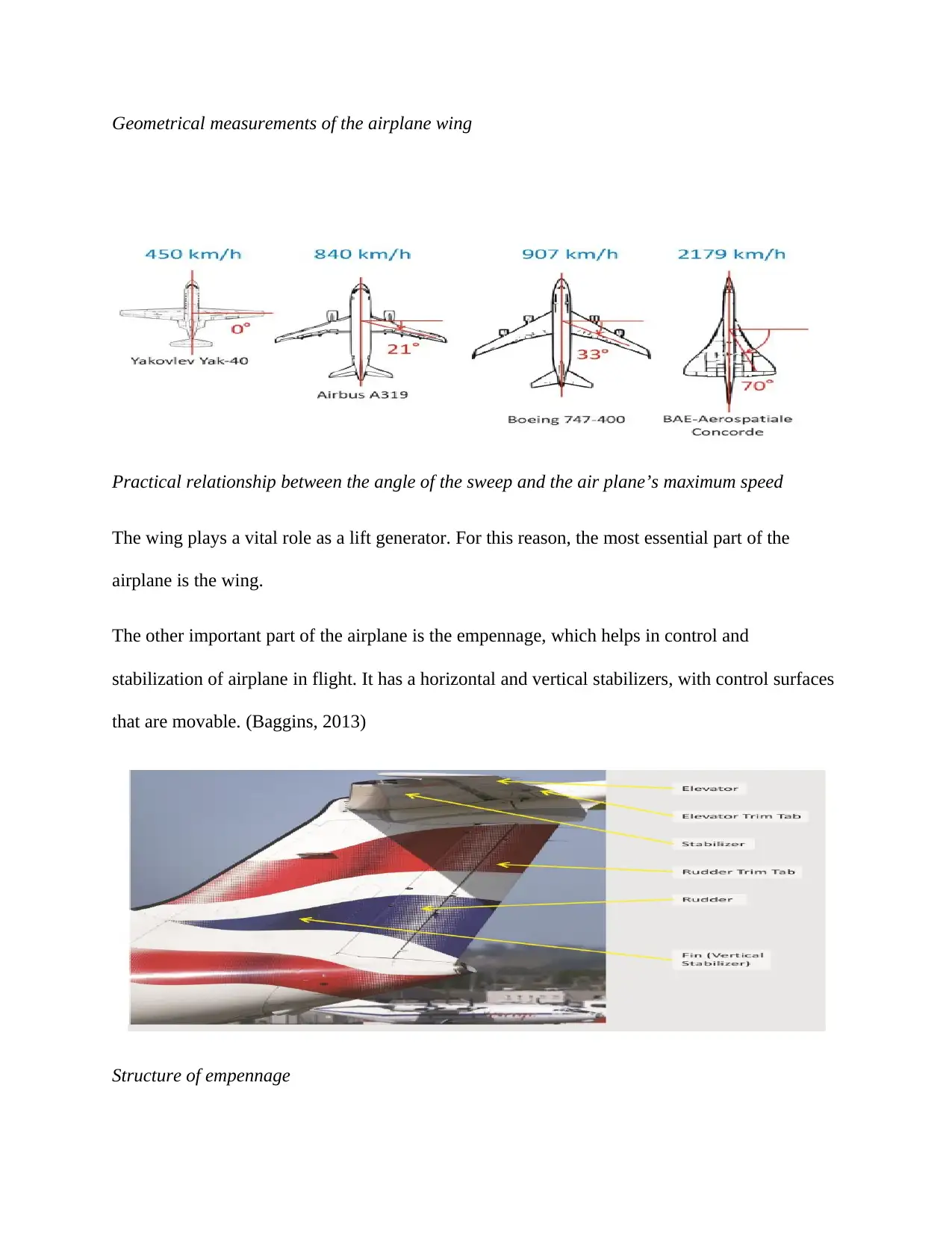
Geometrical measurements of the airplane wing
Practical relationship between the angle of the sweep and the air plane’s maximum speed
The wing plays a vital role as a lift generator. For this reason, the most essential part of the
airplane is the wing.
The other important part of the airplane is the empennage, which helps in control and
stabilization of airplane in flight. It has a horizontal and vertical stabilizers, with control surfaces
that are movable. (Baggins, 2013)
Structure of empennage
Practical relationship between the angle of the sweep and the air plane’s maximum speed
The wing plays a vital role as a lift generator. For this reason, the most essential part of the
airplane is the wing.
The other important part of the airplane is the empennage, which helps in control and
stabilization of airplane in flight. It has a horizontal and vertical stabilizers, with control surfaces
that are movable. (Baggins, 2013)
Structure of empennage
Paraphrase This Document
Need a fresh take? Get an instant paraphrase of this document with our AI Paraphraser
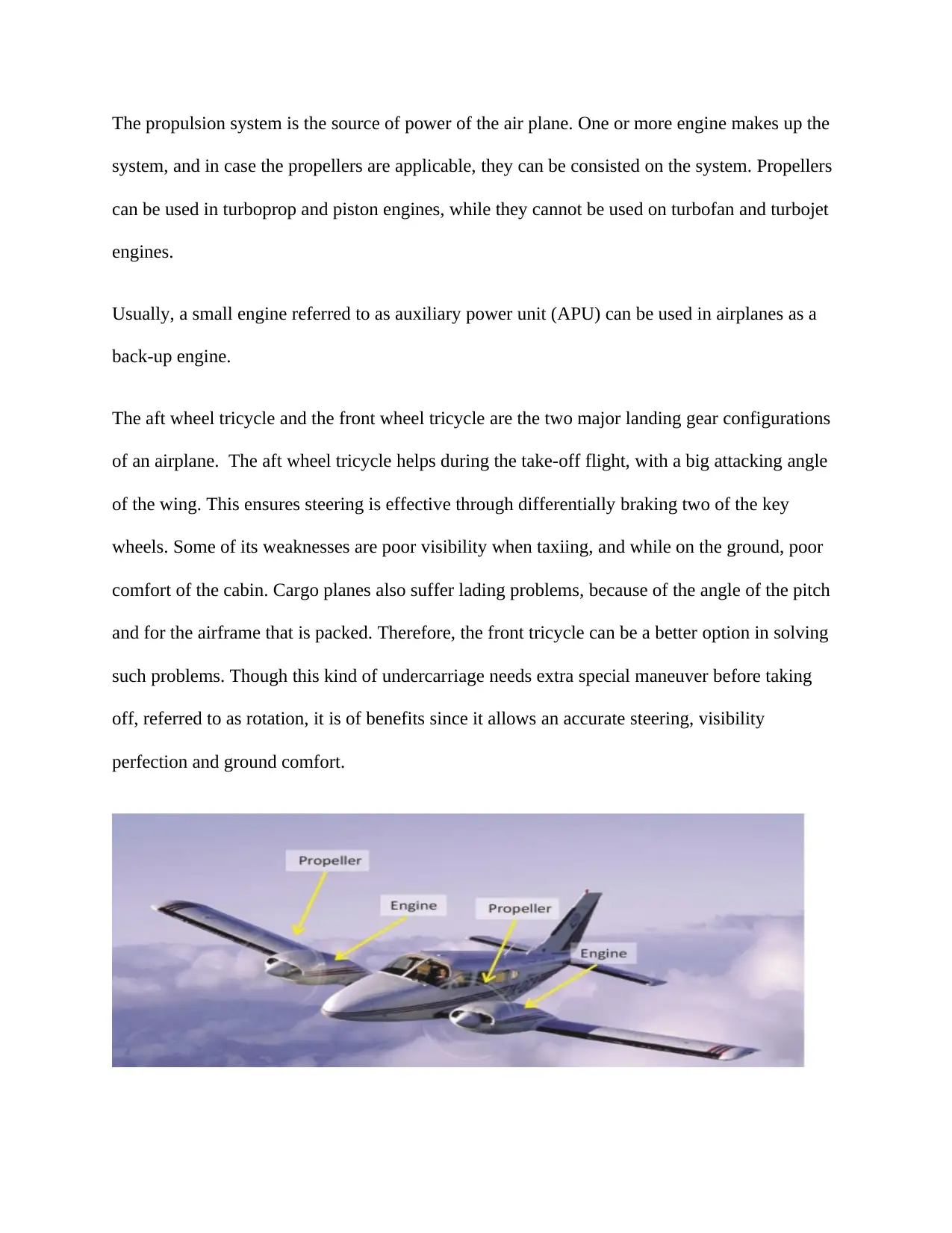
The propulsion system is the source of power of the air plane. One or more engine makes up the
system, and in case the propellers are applicable, they can be consisted on the system. Propellers
can be used in turboprop and piston engines, while they cannot be used on turbofan and turbojet
engines.
Usually, a small engine referred to as auxiliary power unit (APU) can be used in airplanes as a
back-up engine.
The aft wheel tricycle and the front wheel tricycle are the two major landing gear configurations
of an airplane. The aft wheel tricycle helps during the take-off flight, with a big attacking angle
of the wing. This ensures steering is effective through differentially braking two of the key
wheels. Some of its weaknesses are poor visibility when taxiing, and while on the ground, poor
comfort of the cabin. Cargo planes also suffer lading problems, because of the angle of the pitch
and for the airframe that is packed. Therefore, the front tricycle can be a better option in solving
such problems. Though this kind of undercarriage needs extra special maneuver before taking
off, referred to as rotation, it is of benefits since it allows an accurate steering, visibility
perfection and ground comfort.
system, and in case the propellers are applicable, they can be consisted on the system. Propellers
can be used in turboprop and piston engines, while they cannot be used on turbofan and turbojet
engines.
Usually, a small engine referred to as auxiliary power unit (APU) can be used in airplanes as a
back-up engine.
The aft wheel tricycle and the front wheel tricycle are the two major landing gear configurations
of an airplane. The aft wheel tricycle helps during the take-off flight, with a big attacking angle
of the wing. This ensures steering is effective through differentially braking two of the key
wheels. Some of its weaknesses are poor visibility when taxiing, and while on the ground, poor
comfort of the cabin. Cargo planes also suffer lading problems, because of the angle of the pitch
and for the airframe that is packed. Therefore, the front tricycle can be a better option in solving
such problems. Though this kind of undercarriage needs extra special maneuver before taking
off, referred to as rotation, it is of benefits since it allows an accurate steering, visibility
perfection and ground comfort.
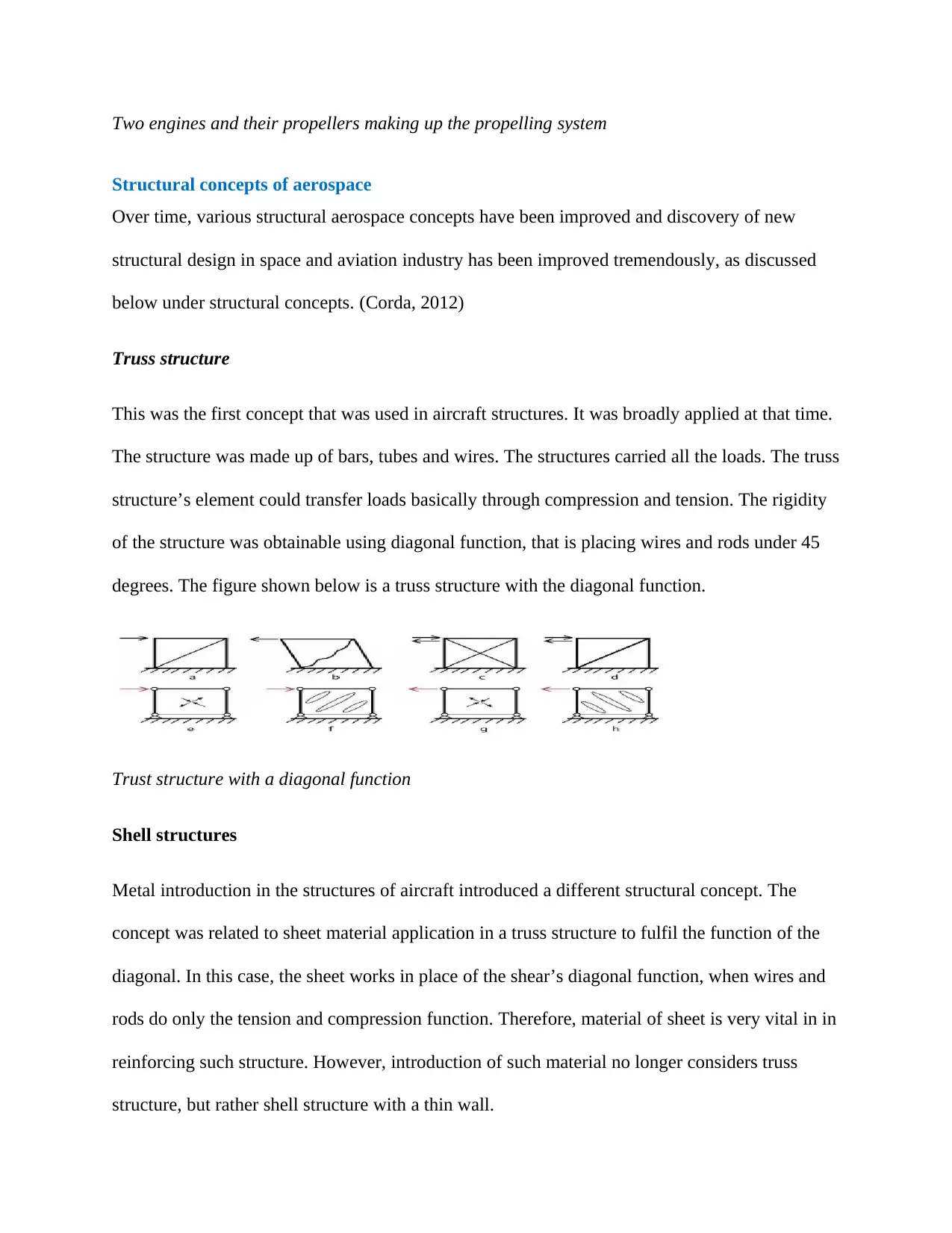
Two engines and their propellers making up the propelling system
Structural concepts of aerospace
Over time, various structural aerospace concepts have been improved and discovery of new
structural design in space and aviation industry has been improved tremendously, as discussed
below under structural concepts. (Corda, 2012)
Truss structure
This was the first concept that was used in aircraft structures. It was broadly applied at that time.
The structure was made up of bars, tubes and wires. The structures carried all the loads. The truss
structure’s element could transfer loads basically through compression and tension. The rigidity
of the structure was obtainable using diagonal function, that is placing wires and rods under 45
degrees. The figure shown below is a truss structure with the diagonal function.
Trust structure with a diagonal function
Shell structures
Metal introduction in the structures of aircraft introduced a different structural concept. The
concept was related to sheet material application in a truss structure to fulfil the function of the
diagonal. In this case, the sheet works in place of the shear’s diagonal function, when wires and
rods do only the tension and compression function. Therefore, material of sheet is very vital in in
reinforcing such structure. However, introduction of such material no longer considers truss
structure, but rather shell structure with a thin wall.
Structural concepts of aerospace
Over time, various structural aerospace concepts have been improved and discovery of new
structural design in space and aviation industry has been improved tremendously, as discussed
below under structural concepts. (Corda, 2012)
Truss structure
This was the first concept that was used in aircraft structures. It was broadly applied at that time.
The structure was made up of bars, tubes and wires. The structures carried all the loads. The truss
structure’s element could transfer loads basically through compression and tension. The rigidity
of the structure was obtainable using diagonal function, that is placing wires and rods under 45
degrees. The figure shown below is a truss structure with the diagonal function.
Trust structure with a diagonal function
Shell structures
Metal introduction in the structures of aircraft introduced a different structural concept. The
concept was related to sheet material application in a truss structure to fulfil the function of the
diagonal. In this case, the sheet works in place of the shear’s diagonal function, when wires and
rods do only the tension and compression function. Therefore, material of sheet is very vital in in
reinforcing such structure. However, introduction of such material no longer considers truss
structure, but rather shell structure with a thin wall.
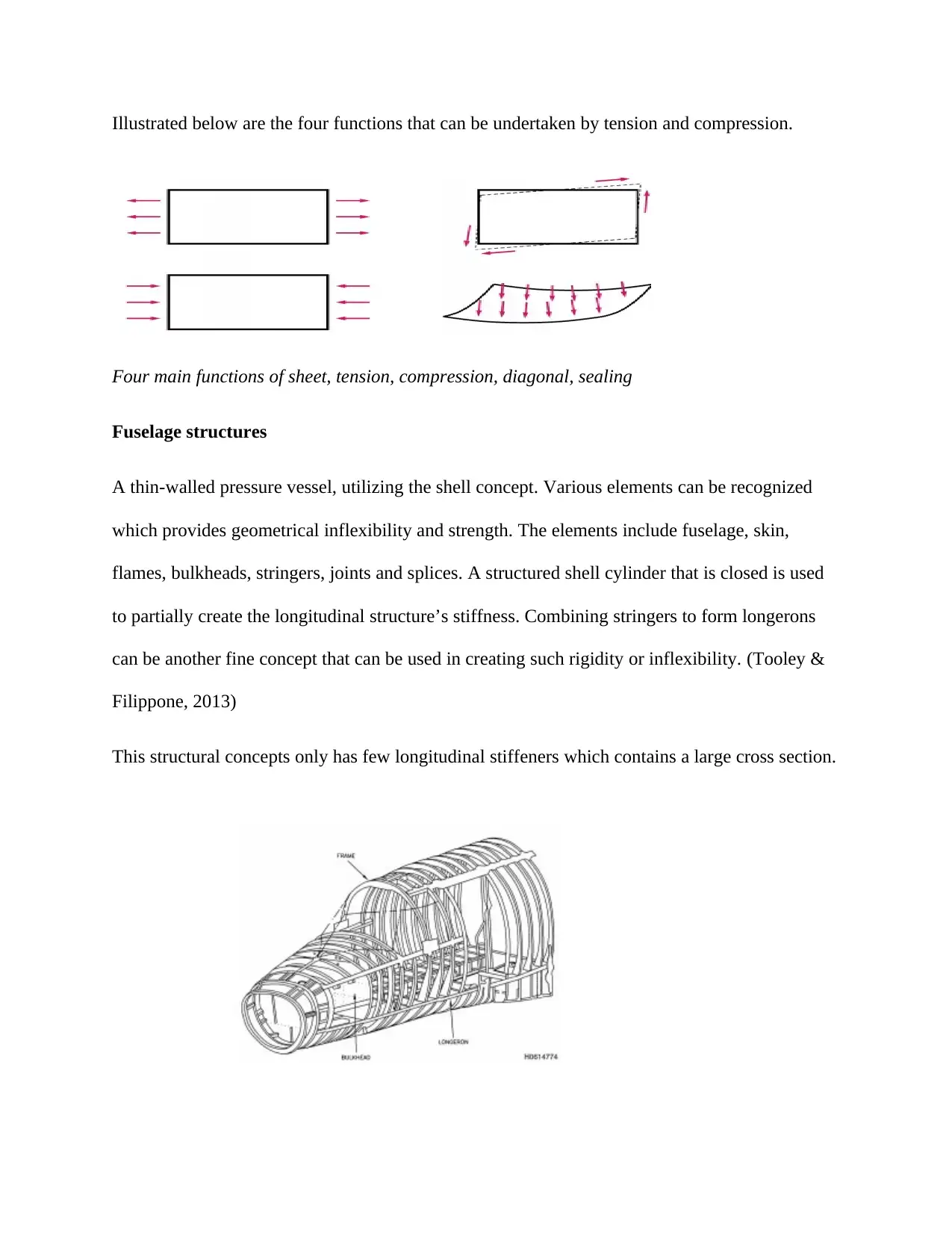
Illustrated below are the four functions that can be undertaken by tension and compression.
Four main functions of sheet, tension, compression, diagonal, sealing
Fuselage structures
A thin-walled pressure vessel, utilizing the shell concept. Various elements can be recognized
which provides geometrical inflexibility and strength. The elements include fuselage, skin,
flames, bulkheads, stringers, joints and splices. A structured shell cylinder that is closed is used
to partially create the longitudinal structure’s stiffness. Combining stringers to form longerons
can be another fine concept that can be used in creating such rigidity or inflexibility. (Tooley &
Filippone, 2013)
This structural concepts only has few longitudinal stiffeners which contains a large cross section.
Four main functions of sheet, tension, compression, diagonal, sealing
Fuselage structures
A thin-walled pressure vessel, utilizing the shell concept. Various elements can be recognized
which provides geometrical inflexibility and strength. The elements include fuselage, skin,
flames, bulkheads, stringers, joints and splices. A structured shell cylinder that is closed is used
to partially create the longitudinal structure’s stiffness. Combining stringers to form longerons
can be another fine concept that can be used in creating such rigidity or inflexibility. (Tooley &
Filippone, 2013)
This structural concepts only has few longitudinal stiffeners which contains a large cross section.
Secure Best Marks with AI Grader
Need help grading? Try our AI Grader for instant feedback on your assignments.
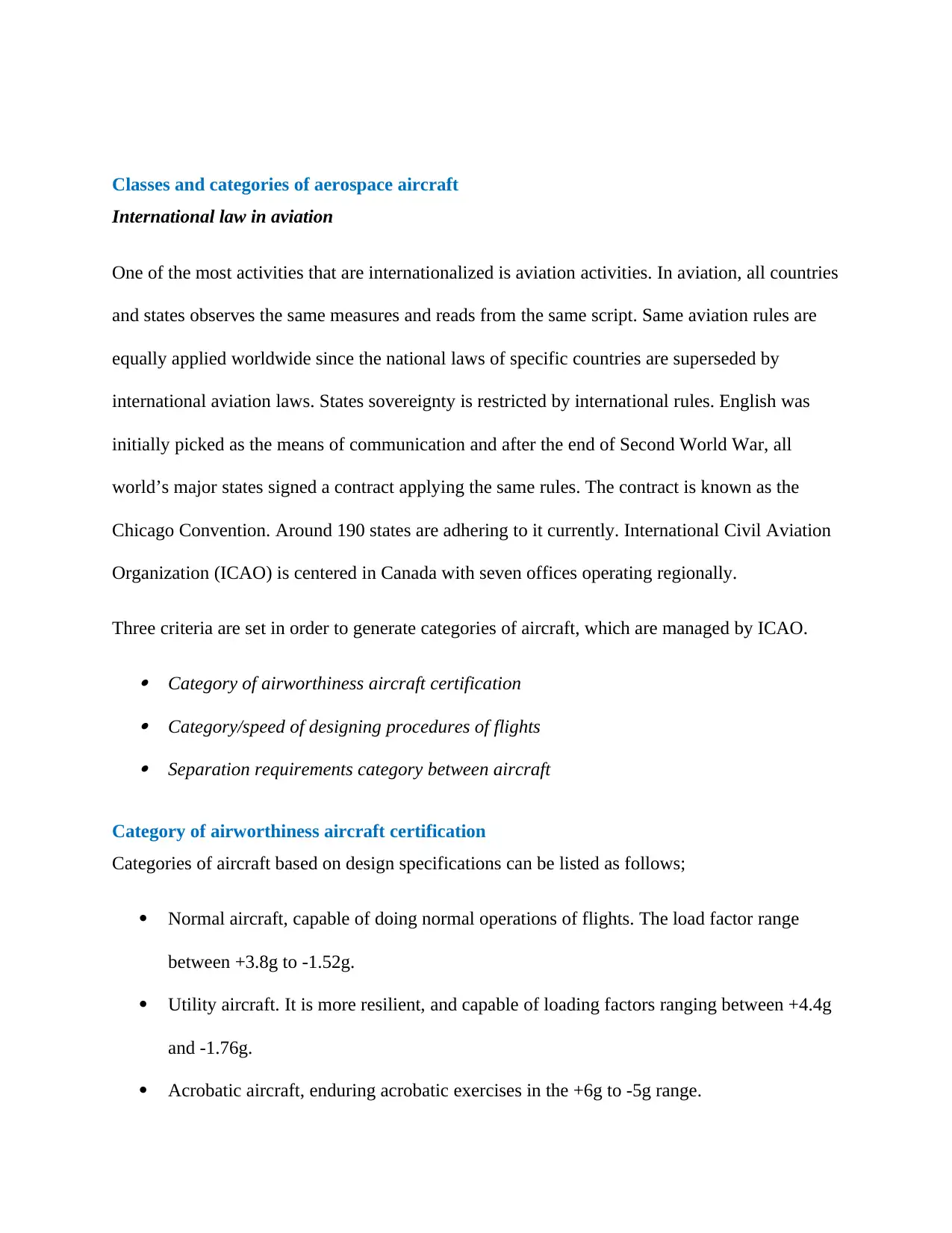
Classes and categories of aerospace aircraft
International law in aviation
One of the most activities that are internationalized is aviation activities. In aviation, all countries
and states observes the same measures and reads from the same script. Same aviation rules are
equally applied worldwide since the national laws of specific countries are superseded by
international aviation laws. States sovereignty is restricted by international rules. English was
initially picked as the means of communication and after the end of Second World War, all
world’s major states signed a contract applying the same rules. The contract is known as the
Chicago Convention. Around 190 states are adhering to it currently. International Civil Aviation
Organization (ICAO) is centered in Canada with seven offices operating regionally.
Three criteria are set in order to generate categories of aircraft, which are managed by ICAO.
Category of airworthiness aircraft certification Category/speed of designing procedures of flights Separation requirements category between aircraft
Category of airworthiness aircraft certification
Categories of aircraft based on design specifications can be listed as follows;
Normal aircraft, capable of doing normal operations of flights. The load factor range
between +3.8g to -1.52g.
Utility aircraft. It is more resilient, and capable of loading factors ranging between +4.4g
and -1.76g.
Acrobatic aircraft, enduring acrobatic exercises in the +6g to -5g range.
International law in aviation
One of the most activities that are internationalized is aviation activities. In aviation, all countries
and states observes the same measures and reads from the same script. Same aviation rules are
equally applied worldwide since the national laws of specific countries are superseded by
international aviation laws. States sovereignty is restricted by international rules. English was
initially picked as the means of communication and after the end of Second World War, all
world’s major states signed a contract applying the same rules. The contract is known as the
Chicago Convention. Around 190 states are adhering to it currently. International Civil Aviation
Organization (ICAO) is centered in Canada with seven offices operating regionally.
Three criteria are set in order to generate categories of aircraft, which are managed by ICAO.
Category of airworthiness aircraft certification Category/speed of designing procedures of flights Separation requirements category between aircraft
Category of airworthiness aircraft certification
Categories of aircraft based on design specifications can be listed as follows;
Normal aircraft, capable of doing normal operations of flights. The load factor range
between +3.8g to -1.52g.
Utility aircraft. It is more resilient, and capable of loading factors ranging between +4.4g
and -1.76g.
Acrobatic aircraft, enduring acrobatic exercises in the +6g to -5g range.
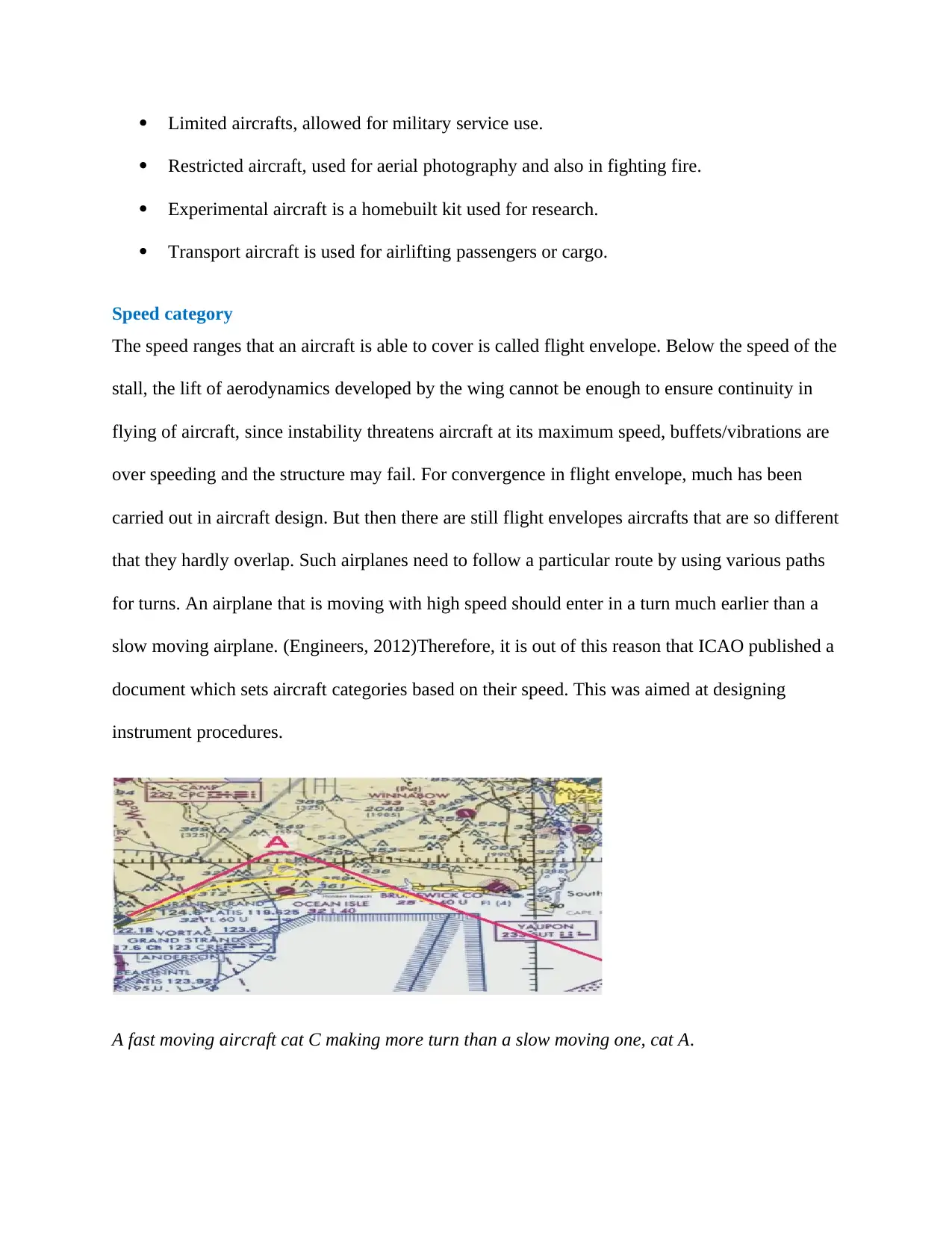
Limited aircrafts, allowed for military service use.
Restricted aircraft, used for aerial photography and also in fighting fire.
Experimental aircraft is a homebuilt kit used for research.
Transport aircraft is used for airlifting passengers or cargo.
Speed category
The speed ranges that an aircraft is able to cover is called flight envelope. Below the speed of the
stall, the lift of aerodynamics developed by the wing cannot be enough to ensure continuity in
flying of aircraft, since instability threatens aircraft at its maximum speed, buffets/vibrations are
over speeding and the structure may fail. For convergence in flight envelope, much has been
carried out in aircraft design. But then there are still flight envelopes aircrafts that are so different
that they hardly overlap. Such airplanes need to follow a particular route by using various paths
for turns. An airplane that is moving with high speed should enter in a turn much earlier than a
slow moving airplane. (Engineers, 2012)Therefore, it is out of this reason that ICAO published a
document which sets aircraft categories based on their speed. This was aimed at designing
instrument procedures.
A fast moving aircraft cat C making more turn than a slow moving one, cat A.
Restricted aircraft, used for aerial photography and also in fighting fire.
Experimental aircraft is a homebuilt kit used for research.
Transport aircraft is used for airlifting passengers or cargo.
Speed category
The speed ranges that an aircraft is able to cover is called flight envelope. Below the speed of the
stall, the lift of aerodynamics developed by the wing cannot be enough to ensure continuity in
flying of aircraft, since instability threatens aircraft at its maximum speed, buffets/vibrations are
over speeding and the structure may fail. For convergence in flight envelope, much has been
carried out in aircraft design. But then there are still flight envelopes aircrafts that are so different
that they hardly overlap. Such airplanes need to follow a particular route by using various paths
for turns. An airplane that is moving with high speed should enter in a turn much earlier than a
slow moving airplane. (Engineers, 2012)Therefore, it is out of this reason that ICAO published a
document which sets aircraft categories based on their speed. This was aimed at designing
instrument procedures.
A fast moving aircraft cat C making more turn than a slow moving one, cat A.
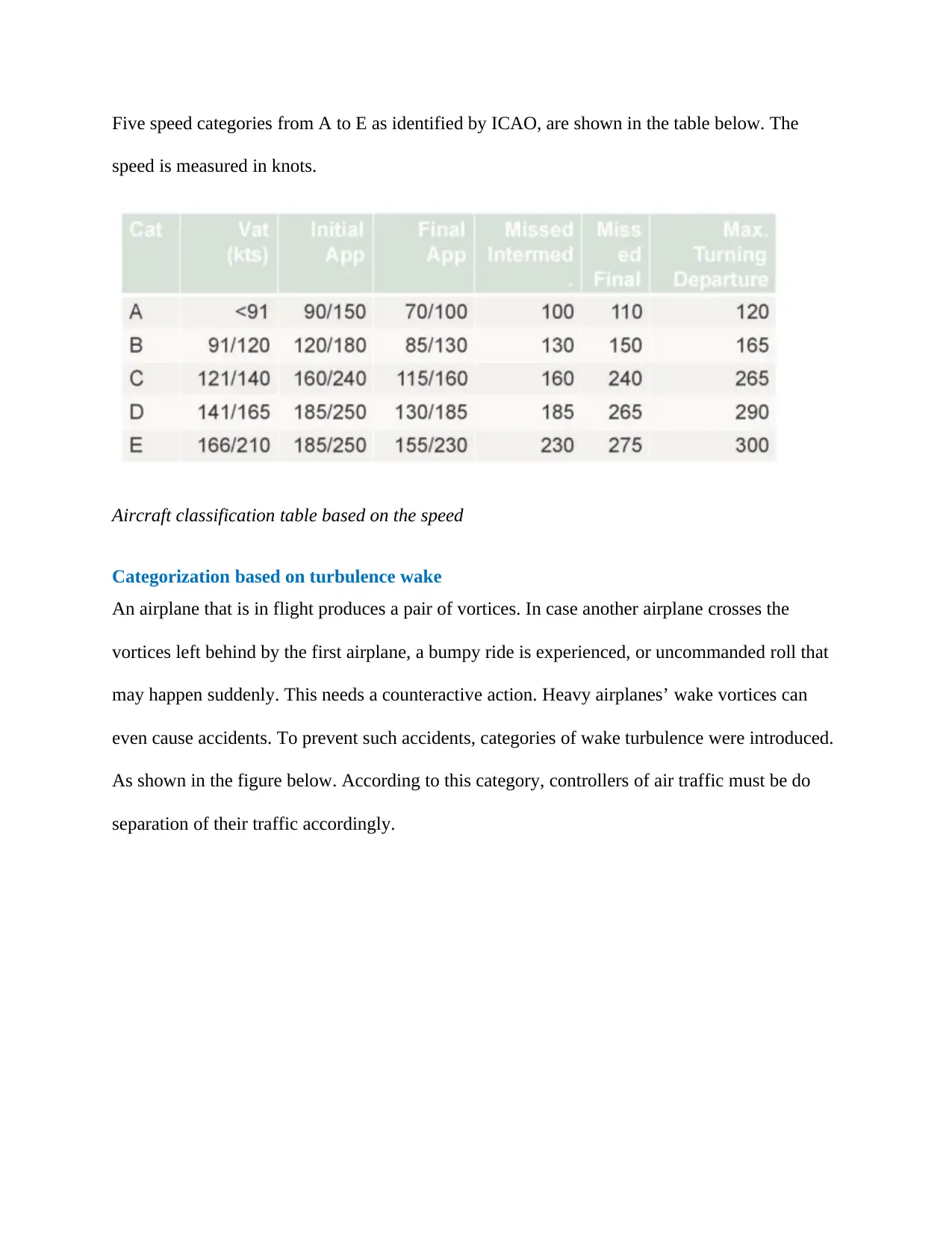
Five speed categories from A to E as identified by ICAO, are shown in the table below. The
speed is measured in knots.
Aircraft classification table based on the speed
Categorization based on turbulence wake
An airplane that is in flight produces a pair of vortices. In case another airplane crosses the
vortices left behind by the first airplane, a bumpy ride is experienced, or uncommanded roll that
may happen suddenly. This needs a counteractive action. Heavy airplanes’ wake vortices can
even cause accidents. To prevent such accidents, categories of wake turbulence were introduced.
As shown in the figure below. According to this category, controllers of air traffic must be do
separation of their traffic accordingly.
speed is measured in knots.
Aircraft classification table based on the speed
Categorization based on turbulence wake
An airplane that is in flight produces a pair of vortices. In case another airplane crosses the
vortices left behind by the first airplane, a bumpy ride is experienced, or uncommanded roll that
may happen suddenly. This needs a counteractive action. Heavy airplanes’ wake vortices can
even cause accidents. To prevent such accidents, categories of wake turbulence were introduced.
As shown in the figure below. According to this category, controllers of air traffic must be do
separation of their traffic accordingly.
Paraphrase This Document
Need a fresh take? Get an instant paraphrase of this document with our AI Paraphraser
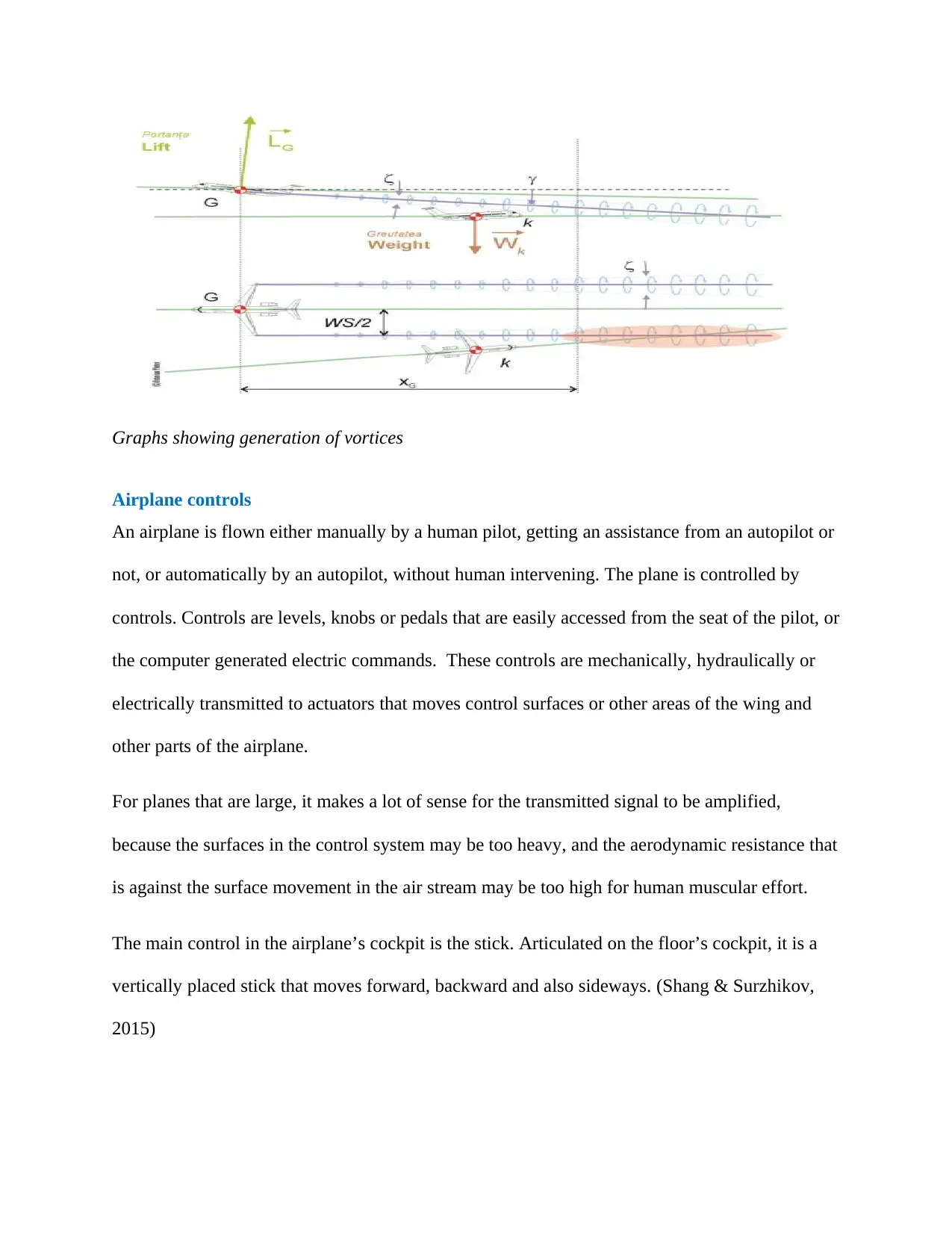
Graphs showing generation of vortices
Airplane controls
An airplane is flown either manually by a human pilot, getting an assistance from an autopilot or
not, or automatically by an autopilot, without human intervening. The plane is controlled by
controls. Controls are levels, knobs or pedals that are easily accessed from the seat of the pilot, or
the computer generated electric commands. These controls are mechanically, hydraulically or
electrically transmitted to actuators that moves control surfaces or other areas of the wing and
other parts of the airplane.
For planes that are large, it makes a lot of sense for the transmitted signal to be amplified,
because the surfaces in the control system may be too heavy, and the aerodynamic resistance that
is against the surface movement in the air stream may be too high for human muscular effort.
The main control in the airplane’s cockpit is the stick. Articulated on the floor’s cockpit, it is a
vertically placed stick that moves forward, backward and also sideways. (Shang & Surzhikov,
2015)
Airplane controls
An airplane is flown either manually by a human pilot, getting an assistance from an autopilot or
not, or automatically by an autopilot, without human intervening. The plane is controlled by
controls. Controls are levels, knobs or pedals that are easily accessed from the seat of the pilot, or
the computer generated electric commands. These controls are mechanically, hydraulically or
electrically transmitted to actuators that moves control surfaces or other areas of the wing and
other parts of the airplane.
For planes that are large, it makes a lot of sense for the transmitted signal to be amplified,
because the surfaces in the control system may be too heavy, and the aerodynamic resistance that
is against the surface movement in the air stream may be too high for human muscular effort.
The main control in the airplane’s cockpit is the stick. Articulated on the floor’s cockpit, it is a
vertically placed stick that moves forward, backward and also sideways. (Shang & Surzhikov,
2015)
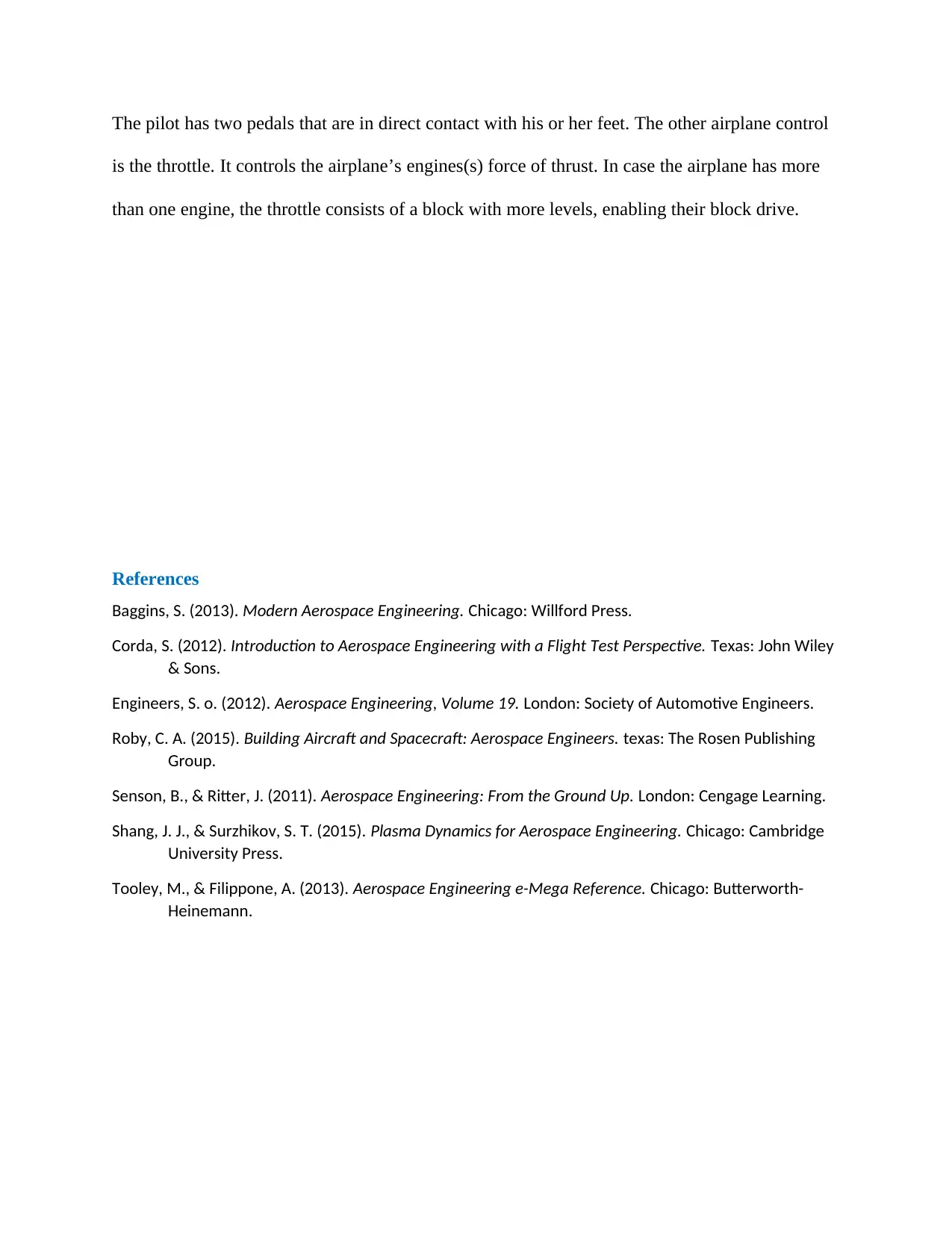
The pilot has two pedals that are in direct contact with his or her feet. The other airplane control
is the throttle. It controls the airplane’s engines(s) force of thrust. In case the airplane has more
than one engine, the throttle consists of a block with more levels, enabling their block drive.
References
Baggins, S. (2013). Modern Aerospace Engineering. Chicago: Willford Press.
Corda, S. (2012). Introduction to Aerospace Engineering with a Flight Test Perspective. Texas: John Wiley
& Sons.
Engineers, S. o. (2012). Aerospace Engineering, Volume 19. London: Society of Automotive Engineers.
Roby, C. A. (2015). Building Aircraft and Spacecraft: Aerospace Engineers. texas: The Rosen Publishing
Group.
Senson, B., & Ritter, J. (2011). Aerospace Engineering: From the Ground Up. London: Cengage Learning.
Shang, J. J., & Surzhikov, S. T. (2015). Plasma Dynamics for Aerospace Engineering. Chicago: Cambridge
University Press.
Tooley, M., & Filippone, A. (2013). Aerospace Engineering e-Mega Reference. Chicago: Butterworth-
Heinemann.
is the throttle. It controls the airplane’s engines(s) force of thrust. In case the airplane has more
than one engine, the throttle consists of a block with more levels, enabling their block drive.
References
Baggins, S. (2013). Modern Aerospace Engineering. Chicago: Willford Press.
Corda, S. (2012). Introduction to Aerospace Engineering with a Flight Test Perspective. Texas: John Wiley
& Sons.
Engineers, S. o. (2012). Aerospace Engineering, Volume 19. London: Society of Automotive Engineers.
Roby, C. A. (2015). Building Aircraft and Spacecraft: Aerospace Engineers. texas: The Rosen Publishing
Group.
Senson, B., & Ritter, J. (2011). Aerospace Engineering: From the Ground Up. London: Cengage Learning.
Shang, J. J., & Surzhikov, S. T. (2015). Plasma Dynamics for Aerospace Engineering. Chicago: Cambridge
University Press.
Tooley, M., & Filippone, A. (2013). Aerospace Engineering e-Mega Reference. Chicago: Butterworth-
Heinemann.
1 out of 15
Related Documents
Your All-in-One AI-Powered Toolkit for Academic Success.
+13062052269
info@desklib.com
Available 24*7 on WhatsApp / Email
![[object Object]](/_next/static/media/star-bottom.7253800d.svg)
Unlock your academic potential
© 2024 | Zucol Services PVT LTD | All rights reserved.





